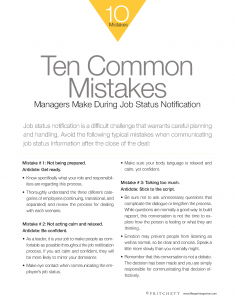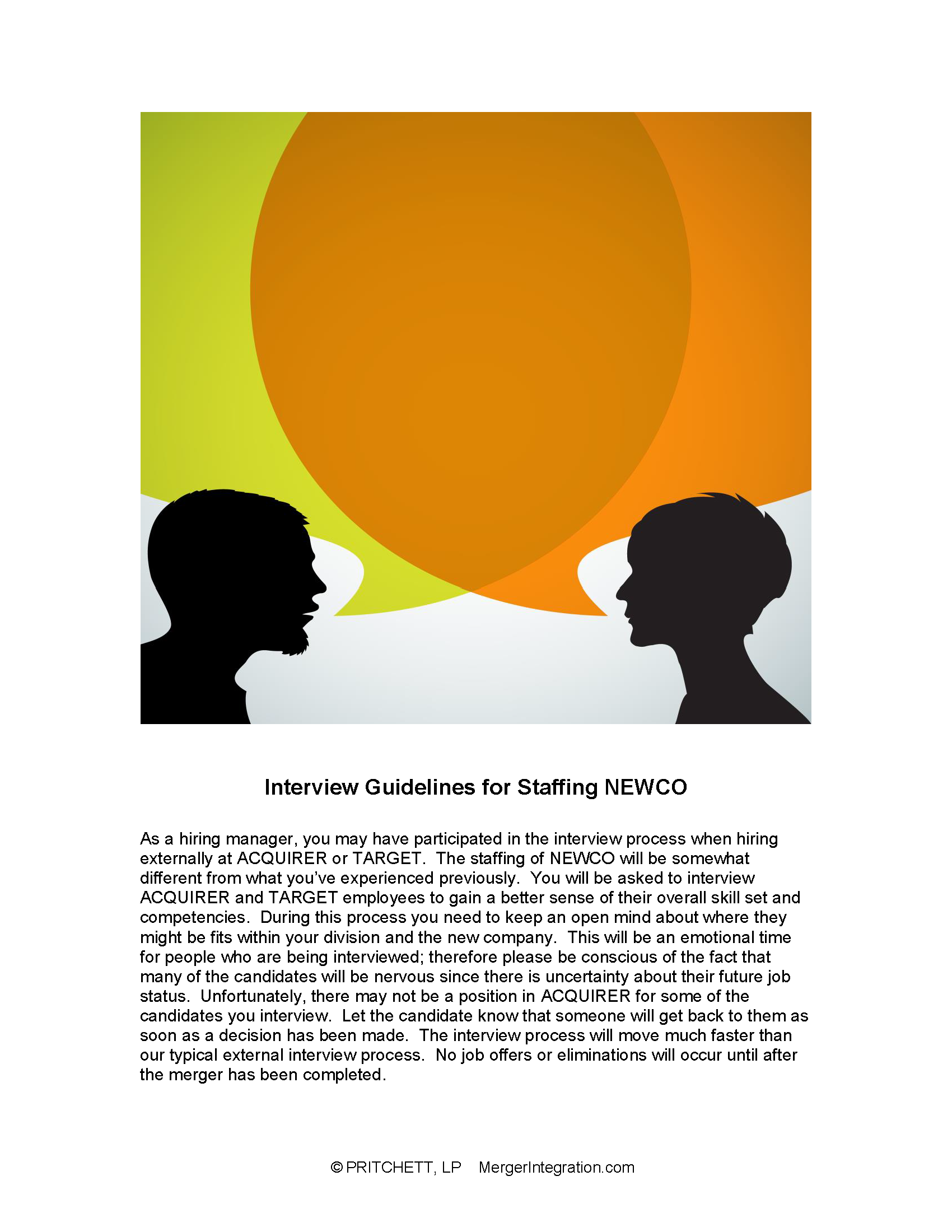Job status notification is a difficult challenge that warrants careful planning and handling. Avoid the following typical mistakes when communicating job status information following the close of the deal:
Mistake # 1: Not being prepared.
Antidote: Get ready.
- Know specifically what your role and responsibilities are regarding this process.
- Thoroughly understand the three different categories of employees (continuing, transitional, and separated) and review the process for dealing with each scenario.
Mistake # 2: Not acting calm and relaxed.
Antidote: Be confident.
- As a leader, it is your job to make people as comfortable as possible throughout the job notification process. If you act calm and confident, they will be more likely to mirror your demeanor.
- Make eye contact when communicating the employee’s job status.
- Make sure your body language is relaxed and calm, yet confident.
Mistake # 3: Talking too much.
Antidote: Stick to the script.
- Be sure not to ask unnecessary questions that complicate the dialogue or lengthen the process. While questions are normally a good way to build rapport, this conversation is not the time to explore how the person is feeling or what they are thinking.
- Emotion may prevent people from listening as well as normal, so be clear and concise. Speak a little more slowly than you normally might.
- Remember that this conversation is not a debate. The decision has been made and you are simply responsible for communicating that decision effectively.
Mistake # 4: Spending too much time.
Antidote: Be brief.
- Job status notification conversations should be brief; no longer than five to ten minutes at most.
- You are only responsible for communicating the job status decision, not all the details of separation, outplacement, transition agreements, or job offers, so just make sure you handle the actual decision communication well.
- If the employee refuses to leave or continues to ask questions beyond what is productive, simply say, “I’d like to end this meeting now. We have other resources that will answer your questions and help you with your concerns.”
Mistake # 5: Trying to be a specialist.
Antidote: Be an authentic leader.
- Don’t try to explain details you don’t fully understand. HR specialists will be present to cover the more complex questions related to benefits and compensation. They will also support you with responses to questions about transition agreements and job offers.
- Focus your time and attention on being an expert on the notification process, the quality of communication, and the interpersonal skill required to conduct these conversations with dignity, respect, and professionalism.
- By honest and authentic. If the employee asks questions you can’t answer, make a note and commit that someone will follow up with a response as soon as possible.
Mistake # 6: Responding to emotion with emotion.
Antidote: Be calm and compassionate.
- Be prepared for emotional reactions. You can expect a full range of responses, including denial, anger, fear, sadness, curiosity, frustration, confusion, and/or relief.
- Don’t try to prevent people from feeling these emotions. Emotions are there to help people work through the transition they are experiencing, so you should allow these emotions to do their work.
- Just make sure that you don’t allow their emotions to escalate your response. You may become the target of their emotion temporarily, but don’t take it personally. Just take a deep breath, compose yourself, and demonstrate respect and compassion for the pain they are feeling.
Mistake # 7: Feeling guilty.
Antidote: Recognize this is nobody’s fault.
- It’s particularly difficult when really good performers lose their job as a result of redundancies or changing business needs. However, that is a hard reality of combining businesses in mergers. It doesn’t help to tell these people not to take it personally. They can’t help but take it personally when they are losing their job.
- Spend some time prior to conducting these conversations getting over any guilt you may feel about the decisions that have been made. You won’t be effective in helping these people deal with their reactions if you are overwhelmed with guilt regarding the decision.
- It’s natural to want to help people in this circumstance, but avoid making promises you shouldn’t extend or can’t keep just to ease the tension of the situation. The best way to help them now is to communicate their job status and refer them to the professional resources in place to help them work through the transition. Avoid the temptation to offer assistance with job search, references, or financial, career, or emotional counseling. Leave those things to the professionals.
Mistake # 8: Focusing too much on the people who are leaving.
Antidote: Balance your attention: first on those who are leaving, then on those who are staying.
- You have dual responsibility during job status notification. You must be equally committed to both those who are leaving and those who are staying. Both need your leadership and attention.
- Plan to spend a significant amount of your time helping continuing employees deal with the “survivor guilt” they may experience as a result of losing bosses, co-workers, or direct reports that they believe did not “deserve” this outcome. It’s not unusual for people who remain to feel guilty about why they have jobs when equally deserving people lost theirs.
- Help those who are asked to leave do so graciously and with dignity. Then quickly turn your attention back to those who remain and help them feel good about the combined organization, its mission, and the opportunity the future holds.
Mistake # 9: Treating people offered transitional agreements differently than continuing employees.
Antidote: Commit to spending time and attention on those you need temporarily.
- Dedicate a significant amount of time each week to checking in with transitional employees to make sure they feel appreciated, connected, and aligned.
- Don’t forget to include them in all communication and activities that continuing employees are entitled to receive.
- Treating transitional employees as “second-class citizens” is likely to result in them exiting prior to completion of their business commitments and may impact integration success significantly.
Mistake #10: Pretending it never happened or didn’t have an impact on others.
Antidote: Acknowledge the reality.
- Don’t sweep under the rug the fact that people have been asked to leave.
- Acknowledge the pain, discuss the business rationale, and address the challenges.
- Channel people’s energy and attention back to customers and business priorities.





